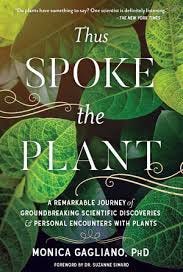The psychedelic renaissance’s relationship to plants can be summed up by a term evolutionary ecologist Monica Gagliano uses in her book Thus Spoke the Plant: Capitalist Agro-Scientific Psychosis.
According to Gagliano, this psychosis amounts to, “an aspect of colonialism whereby plants are seen as commodities to be taken without sanction and the wealth of traditional knowledge regarding them is used without permission.” Her definition could double as a definition of the current psychedelic renaissance. This is one of many reasons why I recommend Thus Spoke the Plant before any of the non-fiction tomes on psychedelics, including and especially Michael Pollan’s books.
Thus Spoke the Plant tells the story of Gagliano’s research into plant communication, detailing how plants listen, learn and remember. Gagliano asks readers to understand plants as sentient beings with subjectivity and will. She calls the book a “phytobiography,” a story written in partnership with plants. In the book, she travels to South America to journey with plants, and goes on a vision quest in California.
Gagliano’s perspective offers a refreshing reprieve from the scientific discourse of the psychedelic renaissance in which irreverence and intuition—despite the fact that they are fundamental parts of the psychedelic experience—are treated as unserious and possibly damaging to the effort to legalize psychedelics. Gagliano comes from inside academia, but her position in the ivory tower started tenuously with scientists in her field ridiculing her research. A colleague once told her researching whether plants can respond to sounds would be “career suicide.” Like Suzanne Simard, Gagliano’s research was eventually accepted and supported by many others who came to similar conclusions. Because of her insider-outsider perspective, Gagliano sees through competing worldviews about plants, both of which are very much alive in the psychedelic renaissance. She writes, “The deterministic view of a world mechanically governed by causes and effects is commonly opposed by the spiritual idealism of new age circles, where the ethereal nature of spiritual reality is favored over the down-to-earth nature of matter. Each obsessed with its own mythology—both worldviews upholding the notion of a separation between mind, body and spirit—the possibility of their full integration into unity and interdependence drops quickly out of sight.”
If you’re serious about psychedelics, I think it naturally follows that you would be serious about plants, and not just plants like peyote or Ayahuasca. It’s common for psychedelic facilitators to pontificate about plant consciousness, yet I often found myself wanting to ask, “But do you even have a garden?” Many of them browbeat others with alleged knowledge about plants they had never seen growing, never seen alive. Gagliano posits forging a different sort of relationship with plants. Thus Spoke the Plant is a marvelous book about plant consciousness, but the only true way to learn about and from plants is by forming a relationship with them. I believe these relationships must extend beyond popping pills in psychedelic therapy. If you don’t have a deep relationship with the plant you’re using, you can’t expect it to give you a deep experience. Gagliano understands the type of shallow-sightedness I’m speaking of this way: “With its quest for a source of intellectual security based on objectivity and materialism, the modern scientific mode of thinking—scientific determinism—has become the accepted procedure for gaining knowledge about the world and a common denominator for Western culture. As a result, the knowledge attained by conventional science is, for the most part, an intellectual enterprise abstracted from the subjective experience of the body, the mind, and the spirit.”
But what I find most hopeful about Gagliano’s perspective is the way she de-centers human intellect and human will, assigning as much power to plants and nature as she does to humans. I believe it’s imperative we view psychedelics in this light. Gagliano’s first experiments involved documenting the voices of plants and showing they can hear noises and respond. “The good news is that by simply asking the question regarding vegetal speech, we are free to move away from the self-righteous slumber we have numbed our mind with,” she writes. “By merely asking the question about plant voice, we set ourselves free from the preconceived notion that construes plants as inevitably voiceless, and we open ourselves to observing plants as they actually behave and to discovering the reality we share. That’s right, because voice is an inter-subjective affair. Voice exists in a place of relation, the space between self and other, and it is what we bring to our encounters with plants that defines the quality of our communicative rendezvous—those we allow to speak (or those we silence).”
All in all, I agree with Gagliano that we cannot control the plant world. Like her, I don’t understand why we’d want to, just as I don’t understand the appeal of synthetic psychedelics vs. experiencing the real plant material, even if it’s messy or bitter. “As long as we need to control our circumstances, we also need to feel unsafe and insecure about them, because the two states are bound together in a self-perpetuating and irreconcilable loop that goes something like this: we try to control because we feel unsafe and believe that by controlling our world, we will feel safe in it—and yet we never do, and we cannot feel safe in the world if we keep believing that the world needs controlling because, without our control, there is something unsafe about it.”
Amen.



